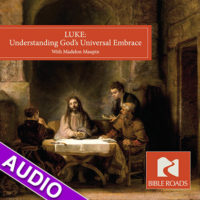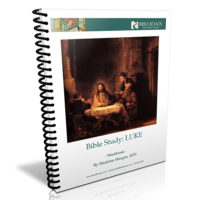December has been a month of pouring over Luke’s Gospel. If you watched the Luke Webinar * then you already know how much the evangelist is responsible for grounding the birth of Jesus in history, as well as learning of his deep ties to the Hebrew Scriptures.
One of the earliest examples of these Old Testament ‘echoes’ occurs in Luke 1: 46-56. This song-like prayer of Mary’s gratitude and glory is often referred to as the Magnificat, from the opening word in the Latin translation. It is a key passage loved for its beauty and content, and instrumental in establishing the Gospel’s themes to come. Written in the voice of Mary, it is her heartfelt response to the angelic news that she is to have a child through the Holy Spirit.
Written in two parts, the beginning (Luke 1:46-49) is a self-revealing statement of Mary’s humility, perhaps due to her economic and social low estate, which she cites. But more, we realize her humbleness comes from a deep willingness to give her whole self to the service of God as she is led, regardless of the cost.
What’s striking in the hymn’s second half (Luke 1:50-55) is the tense used: God’s redeeming work has already been fulfilled. Rather than a hymn of praise hoping for God’s rescue and redemption of Israel, Mary perceives and acknowledges that it has occurred: God ‘has shown’ strength; He ‘has scattered’ the proud, etc. with the beneficiaries being the disenfranchised poor and powerless–a theme Luke returns to repeatedly.
Students of the Old Testament will recognize the echo to Hannah’s song in I Sam. 2:1-10, an ancient hymn of Thanksgiving for answered prayers. The first half of I Samuel is about this special child’s birth, a cause of great rejoicing after we learn (I Sam. 1:2) that Hannah’s husband Elkanah and she have no children. Unlike Mary, Hannah had been trying to have a child her entire marriage but had been unable, despite her husband’s ability to bear children through his second wife. Clearly Hannah felt she was at fault for this ancient curse of infertility.
When the priest Eli saw her sadness and deep prayer, he reassured her that ‘the God of Israel grant the petition you have made to him’ (I Sam. 1:17). Hannah conceives and her gratitude is palpable in reading her prayer (I Sam. 2:1-10). Both open with a couplet praising God and describing the dramatic reversal that is the evidence of God’s presence and power. Hannah’s prayer describes a series of reversal of fortunes such as raising the poor, lifting the needy, providing places for them at the table of the wealthy. Her pregnancy is such a reversal.
Reading both the hymns of Mary and Hannah reveals how much they glimpsed the hugeness of God, the awesome, unstoppable power of their God. Reading them, either this Christmas season or any time we want to feel God’s care and allness, is a way to sense how enormous and yet individual is God’s great love.
*Available at no cost until midnight, 12/31/14. Click this link.





Dear Madelon, Thank you for what you are doing. We have enjoyed your inspiration you have shared so generously at the Bible Seminars in California for many years.
We bought your series there when we were there in 2013. We look forward to your continuing inspiration through this program you are giving.
We recently moved to Issaquah, Washington from David’s former home in Bothell, Washington. We will fly to Kauai for the winter months next week and be there until May.
Shirley and Davie Dauterman